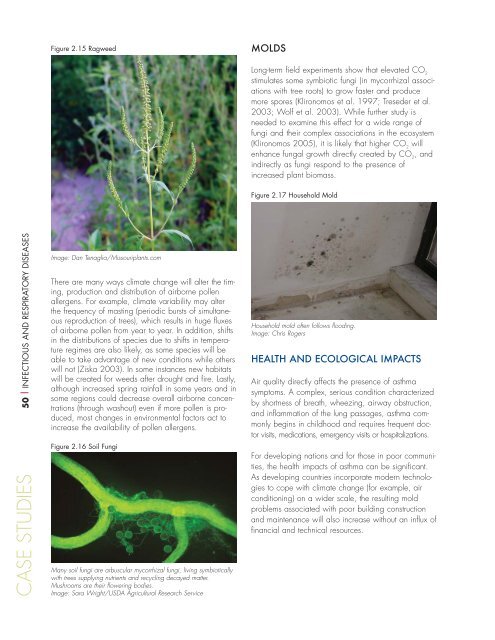Climate change futures: health, ecological and economic dimensions
Climate change futures: health, ecological and economic dimensions
Climate change futures: health, ecological and economic dimensions
You also want an ePaper? Increase the reach of your titles
YUMPU automatically turns print PDFs into web optimized ePapers that Google loves.
Figure 2.15 Ragweed<br />
MOLDS<br />
Long-term field experiments show that elevated CO 2<br />
stimulates some symbiotic fungi (in mycorrhizal associations<br />
with tree roots) to grow faster <strong>and</strong> produce<br />
more spores (Klironomos et al. 1997; Treseder et al.<br />
2003; Wolf et al. 2003). While further study is<br />
needed to examine this effect for a wide range of<br />
fungi <strong>and</strong> their complex associations in the ecosystem<br />
(Klironomos 2005), it is likely that higher CO 2<br />
will<br />
enhance fungal growth directly created by CO 2<br />
, <strong>and</strong><br />
indirectly as fungi respond to the presence of<br />
increased plant biomass.<br />
Figure 2.17 Household Mold<br />
50 | INFECTIOUS AND RESPIRATORY DISEASES<br />
CASE STUDIES<br />
Image: Dan Tenaglia/Missouriplants.com<br />
There are many ways climate <strong>change</strong> will alter the timing,<br />
production <strong>and</strong> distribution of airborne pollen<br />
allergens. For example, climate variability may alter<br />
the frequency of masting (periodic bursts of simultaneous<br />
reproduction of trees), which results in huge fluxes<br />
of airborne pollen from year to year. In addition, shifts<br />
in the distributions of species due to shifts in temperature<br />
regimes are also likely, as some species will be<br />
able to take advantage of new conditions while others<br />
will not (Ziska 2003). In some instances new habitats<br />
will be created for weeds after drought <strong>and</strong> fire. Lastly,<br />
although increased spring rainfall in some years <strong>and</strong> in<br />
some regions could decrease overall airborne concentrations<br />
(through washout) even if more pollen is produced,<br />
most <strong>change</strong>s in environmental factors act to<br />
increase the availability of pollen allergens.<br />
Figure 2.16 Soil Fungi<br />
Many soil fungi are arbuscular mycorrhizal fungi, living symbiotically<br />
with trees supplying nutrients <strong>and</strong> recycling decayed matter.<br />
Mushrooms are their flowering bodies.<br />
Image: Sara Wright/USDA Agricultural Research Service<br />
Household mold often follows flooding.<br />
Image: Chris Rogers<br />
HEALTH AND ECOLOGICAL IMPACTS<br />
Air quality directly affects the presence of asthma<br />
symptoms. A complex, serious condition characterized<br />
by shortness of breath, wheezing, airway obstruction,<br />
<strong>and</strong> inflammation of the lung passages, asthma commonly<br />
begins in childhood <strong>and</strong> requires frequent doctor<br />
visits, medications, emergency visits or hospitalizations.<br />
For developing nations <strong>and</strong> for those in poor communities,<br />
the <strong>health</strong> impacts of asthma can be significant.<br />
As developing countries incorporate modern technologies<br />
to cope with climate <strong>change</strong> (for example, air<br />
conditioning) on a wider scale, the resulting mold<br />
problems associated with poor building construction<br />
<strong>and</strong> maintenance will also increase without an influx of<br />
financial <strong>and</strong> technical resources.

















